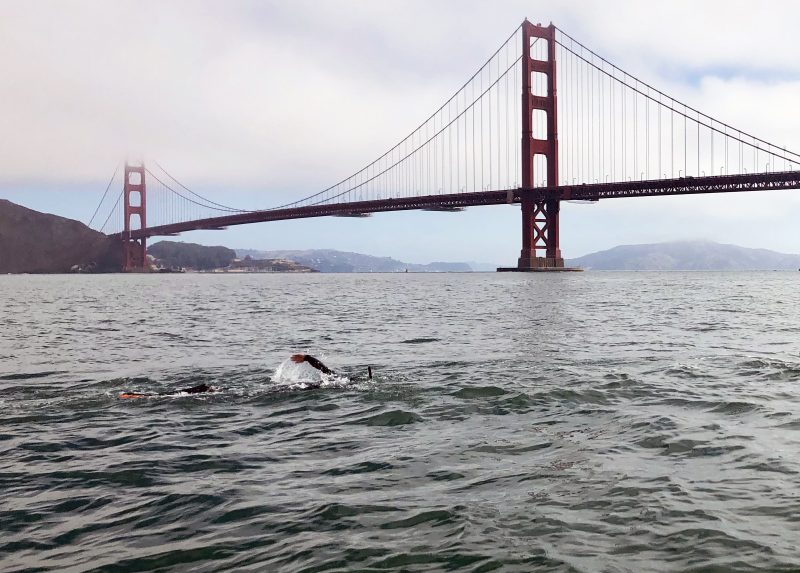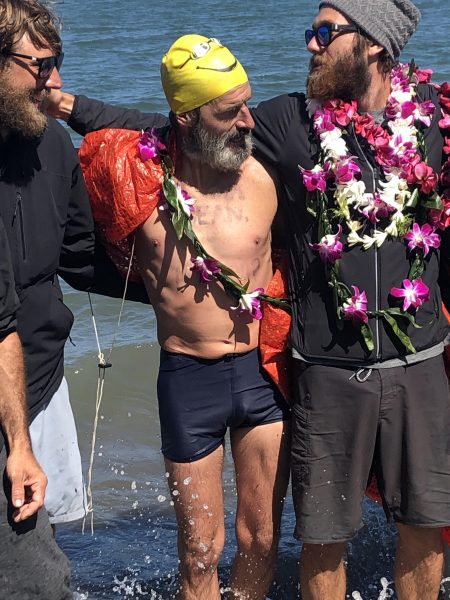
Man Swims Through Pacific Garbage Patch to Raise Awareness
On Saturday, a French long-distance swimmer and his support crew swam and sailed underneath the Golden Gate Bridge to mark the conclusion of an 80-day expedition from Hawaii into San Francisco. Benoît Lecomte, or Ben, swam several legs totaling 350 nautical miles as part of The Vortex Swim to raise awareness about plastic pollution. The team was greeted under the Golden Gate Bridge by the Dolphin Swim & Boat Club, the Bay Area Sea Kayakers, and other local supporters as Ben made his way onto land near Crissy Field.
Ben was followed by nine support crew on the Challenge 67 cutter-rigged sloop I Am Ocean, which was originally built for the Global Challenge round the world race, and has since been converted to a science laboratory, floating hospital, and home for 10 people.

The Vortex Swim — which has also been called The Longest Swim — was originally Ben’s attempt to be the first person to swim across the Pacific from Japan to Hawaii, but was aborted in July due to a series of storms. After spending a few months of maintenance and repairs in Hawaii, the team redirected their mission to swim through the Great Pacific Garbage Patch to collect samples of the ocean plastic pollution. The crew reflected what many have said after laying eyes on the Garbage Patch: It looked less like an island of garbage, but rather, “chunky soup” and “a smog of microplastics. Over 200 samples were taken and 45,000 microplastics collected.

The crew said the expedition was different from being on a commercial fishing boat or container ship. Their slow speed allowed them to essentially drift and observe the problem up close. The Vortex team call themselves trash as opposed to treasure hunters. One person stood a debris watch every 30 minutes throughout the expedition to take note of the type and dispersion of plastic.
First Mate Tyral Dalitz said they had to sail at an unusually slow pace to stay with Ben, and in so doing, discovered a new sailing technique specific to following swimmers called the ‘Hove 3’, similar to the more conventional hove-to technique. “We backed the headsail and tacked the staysail so that the waypoint is higher in the wind and we still had a bit more direction, but would go extra-slow to keep pace with the swimmer; this was invented by the swim crew, and must go down in history!” By sailing instead of motoring, the team was able to save tens of thousands of dollars.

Doctor Adam Hill said I Am Ocean carried all the supplies a hospital would have in case of any emergencies. Hill’s job was to keep Ben alive and healthy, making sure he stayed hydrated and was consuming enough calories when swimming 8-12 hours a day — this meant that that there was a lot more food onboard that was normal for 10 crew members.

Ben said because he gets seasick, he preferred to be in the water swimming rather than on the boat. He described swimming in big waves similar to being like a cork bouncing and floating; by contrast, Ben said that he was violently flung around the boat.
Ben and the Vortexswim crew are part of a growing number of activists raising awareness about marine plastic pollution through adventuring and scientific observation.

Epic achievement from Ben and his crew.
But more than that, I think they show us a different way to sail.
As sailors, we’re naturally eager to tune our boats to go as fast as possible, and find the optimal route between two points. But by slowing down to a crawl, this crew experienced a completely different passage. Their stories and footage from swimming with albatross, and whales, and dolphins in the wide blue ocean were magical.
Maybe we need a slow sailing movement as well as the slow food movement!?
I was also struck by how enthusiastic they were about the all the life they saw in just the last two days as they approached the coast. We have an aquatic wonderland right on our doorstep.